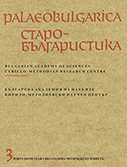Роднинската терминология в славянски правни текстове от Късното средновековие (Допълнението от XVII в. в ръкопис ЦИАИ 1160)
The Kinship Terminology in Slavonic Legal Texts from the Late Middle Ages (The 17th Century Supplement to the Ms. Slav. CIAI 1160)
Author(s): Mariyana Tsibranska-KostovaSubject(s): Language studies, Language and Literature Studies
Published by: Кирило-Методиевски научен център при Българска академия на науките
Keywords: South Slavic diachronic kinship; Zacharias Scordylias; Slavic legal translations in the Late Middle Ages.
Summary/Abstract: The article analyzes the fifteen folia (ff. 206–220) added in the 17th century to the Ms. Slav. 1160 from the collection of the Church Historical and Archival Institute of the Bulgarian Patriarchate in Sofia (CIAI 1160). The 14th century manuscript is the earliest preserved legal miscellany in Bulgaria. The supplement is identified as a copy of Zacharias Scordylios’ work on the degrees of kinship and the forbidden marriages that was first published in Venice in 1563 as part of the Greek Horologion, and independently in 1588 in a vernacular version. The main tasks are to reveal the connection between this addition and the core text of the manuscript; to determine its linguistic affiliation on the basis of the representatives in the lexico-semantic group of kinship terms by comparison to both the terminology in the main part of CIAI 1160, and the Slavic legal literature of the Late Middle Ages. It is concluded that: 1. A characteristic feature of the translation of Scordylios’ work is the choice of a generalizing term which has a dual meaning to denote kinship in both male and female lines, compare стрицъ, тетька against уика, леля in the main body; 2. A similar generalization is achieved with синовьць and синовица that replace братаньць, братанька, сестричь, сестричьнъ; 3. To designate a more distant relationship no new term is coined, but a word-forming element is added to the main term (пре/прамама, пре/правъноука), or the latter forms a compound term with a numeral or an adjective: велика тетька, великъ стриць, вътора баба, мала тетька, трета баба, трета въноука; 4. Rare lexemes are attested: пасторъка, пасторъкъ, пашеногъ, пращоура. The presented data enrich the history of the Bulgarian kinship terminology and testify to the importance of blood and family ties for the preservation of identity during the Ottoman times on the Balkans. The supplement to CIAI 1160 seems to have been copied in a western (probably southwestern) area, in a contact zone between Serbian and Bulgarian dialects. As for the translation itself, given the active relations of Venice with some Athonite monasteries and printing shops on the Balkans during the 16th century, it could have been carried out in many centers. Nevertheless, the territories historically subordinated to the Ohrid archbishopry, from which some copies of Syntagma of Matthew Blastares originated, might have been the area where the supplement was presumably written. The translation appeared in the last quarter of the 16th century at the earliest.
Journal: PALAEOBULGARICA / СТАРОБЪЛГАРИСТИКА
- Issue Year: 2022
- Issue No: 3
- Page Range: 57-79
- Page Count: 23
- Language: Bulgarian
- Content File-PDF

